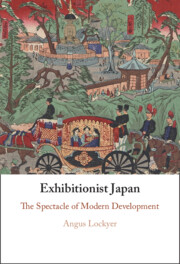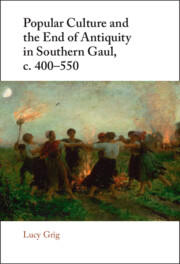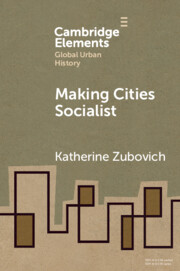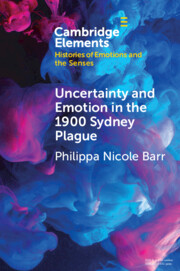Refine search
Actions for selected content:
151 results
7 - Renewable Energy and Energy Efficiency in Circular Economy Liveable Cities
-
-
- Book:
- The Circular Economy and Liveable Cities
- Published online:
- 05 September 2025
- Print publication:
- 04 September 2025, pp 101-111
-
- Chapter
- Export citation
Chapter 4 - The Geographies of British Postmodern Fiction
-
-
- Book:
- The Cambridge Companion to British Postmodern Fiction
- Published online:
- 07 August 2025
- Print publication:
- 21 August 2025, pp 66-81
-
- Chapter
- Export citation
5 - The Heterogeneity of the Italian Civitates
-
- Book:
- Wealth, Office and Rank in Roman Italy
- Published online:
- 23 July 2025
- Print publication:
- 17 July 2025, pp 93-106
-
- Chapter
-
- You have access
- Open access
- Export citation
19 - Local Government Law for the 100-Year Life
- from Part IV - The 100-Year Life and Our Broader Environment
-
-
- Book:
- Law and the 100-Year Life
- Published online:
- 13 May 2025
- Print publication:
- 29 May 2025, pp 258-270
-
- Chapter
-
- You have access
- Open access
- HTML
- Export citation
Why and How to Walk a City
-
- Journal:
- Asia-Pacific Journal / Volume 21 / Issue 12 / December 2023
- Published online by Cambridge University Press:
- 14 March 2025, e1
-
- Article
-
- You have access
- Open access
- Export citation
13 - The Parable of the Pounds (Lk 19:1–27)
-
- Book:
- Luke's Unique Parables
- Published online:
- 28 February 2025
- Print publication:
- 06 March 2025, pp 155-172
-
- Chapter
- Export citation
1 - The End of the Ancient City?
-
- Book:
- The Idea of the City in Late Antiquity
- Published online:
- 30 January 2025
- Print publication:
- 27 February 2025, pp 1-32
-
- Chapter
- Export citation
Chapter 6 - Resettling the Shephelah
- from Part II - The Archaeology of the Tenth Century BCE
-
- Book:
- The Bible's First Kings
- Published online:
- 16 January 2025
- Print publication:
- 20 February 2025, pp 148-172
-
- Chapter
- Export citation

Exhibitionist Japan
- The Spectacle of Modern Development
-
- Published online:
- 06 February 2025
- Print publication:
- 13 February 2025
6 - All Aboard? Inclusiveness in Collaborative Governance among Swedish Municipalities
-
-
- Book:
- The Politics and Governance of Decarbonization
- Published online:
- 05 December 2024
- Print publication:
- 28 November 2024, pp 119-138
-
- Chapter
-
- You have access
- Open access
- HTML
- Export citation
7 - Zeroing In on Cities: The Politics of Aspiration and Delay in Net-Zero Emission Targets of Swedish Municipalities
-
-
- Book:
- The Politics and Governance of Decarbonization
- Published online:
- 05 December 2024
- Print publication:
- 28 November 2024, pp 139-160
-
- Chapter
-
- You have access
- Open access
- HTML
- Export citation
1 - Introduction and Overview
-
- Book:
- Urban Nature
- Published online:
- 14 November 2024
- Print publication:
- 07 November 2024, pp 1-6
-
- Chapter
- Export citation
Diagnosis on the implementation of the New Urban Agenda
-
- Journal:
- Global Sustainability / Volume 7 / 2024
- Published online by Cambridge University Press:
- 25 September 2024, e37
-
- Article
-
- You have access
- Open access
- HTML
- Export citation
‘Princely seats’ and Thessalian hillforts: pre-urban Greece and the diffusion of urbanism in Early Iron Age Europe
-
- Article
-
- You have access
- Open access
- HTML
- Export citation

Popular Culture and the End of Antiquity in Southern Gaul, c. 400–550
-
- Published online:
- 15 March 2024
- Print publication:
- 28 March 2024
-
- Book
-
- You have access
- Open access
- Export citation
2 - Deterritorialisation Discourse in International Law
-
- Book:
- The Rebirth of Territory
- Published online:
- 07 March 2024
- Print publication:
- 14 March 2024, pp 30-70
-
- Chapter
- Export citation

Making Cities Socialist
-
- Published online:
- 02 March 2024
- Print publication:
- 04 April 2024
-
- Element
- Export citation

Uncertainty and Emotion in the 1900 Sydney Plague
-
- Published online:
- 16 February 2024
- Print publication:
- 11 April 2024
-
- Element
- Export citation
Measuring It, Managing It, Fixing It? Data and Rights in Transnational and Local Climate Change Governance
-
- Journal:
- Transnational Environmental Law / Volume 13 / Issue 1 / March 2024
- Published online by Cambridge University Press:
- 06 February 2024, pp. 111-133
-
- Article
-
- You have access
- Open access
- HTML
- Export citation
16 - The 2030 Agenda, Climate Urbanism and Urban Planning in Zimbabwe
- from Part III - Sustainable Urban Planning in Africa
-
-
- Book:
- Reimagining Urban Planning in Africa
- Published online:
- 07 December 2023
- Print publication:
- 21 December 2023, pp 282-302
-
- Chapter
- Export citation
